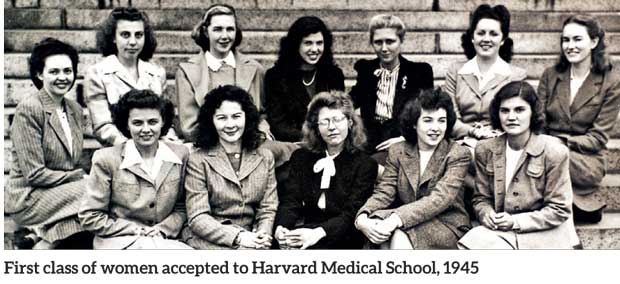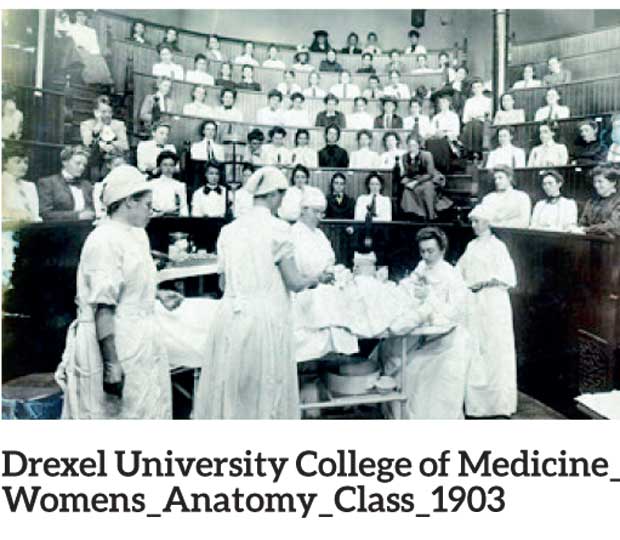10 Nov 2017 - {{hitsCtrl.values.hits}}
 Kumar and Clark’s Clinical Medicine is one of the most acclaimed international publications in medicine for undergraduates and junior doctors. It’s considered as the bible in the subject of medicine by many Sri Lankan medical students, including this writer.
Kumar and Clark’s Clinical Medicine is one of the most acclaimed international publications in medicine for undergraduates and junior doctors. It’s considered as the bible in the subject of medicine by many Sri Lankan medical students, including this writer.
Only recently did I get to know that the famous ‘Praveen Kumar’, of the Kumar and Clark’s’ Clinical Medicine was, in fact, a woman. I was very thrilled by this fact not because I am a woman, but because contrary to popular belief, medicine still very much a male dominated field.
While around 50% of the student population who enter medical faculty are females, only a small percentage of them make further progress, either in the academic arena or in other specialized fields. Even when they choose to specialize in, it’s found that there are fields that women are ‘expected to specialize in’. Some fields like orthopaedic surgery are by definition ‘testosterone only’ fields. But the situation is improving steadily and hopefully there will come a day when I don’t have to feel proud because a ‘woman’ achieved something big in the field of medicine, because everyone would be judged on their talent and not by gender.

My article isn’t going to be a ‘feminist’ piece, but hopefully this will grab the attention of everyone who have aspirations to elevate themselves from where they are now. I say this because women in medicine have experienced a slow journey where they have had to shed a lot of blood sweat and tears on the way. Before 1800’s, women were banned from enrolling at medical schools. A female was considered too intellectually inferior to become a doctor. Dr. James Miranda Steuart Barry, born in 1790’s, was one of the first western female doctors to qualify in the recorded history of medicine. Known to the world as James Barry, she managed to join the military as a surgeon and became the second highest medical office. She also performed one of the first successful caesarean surgeries all the while concealing the fact that she was a woman, for 56 years. Her sex was revealed only after her death, when her body was being prepared for burial. A few years later, Elizabeth Blackwell became the first woman to enter a medical faculty. It’s ironic that after being rejected from more than 29 medical colleges, she was finally accepted, not because the administration recognized her qualifications, which surpassed those of her male peers, more as a joke. History reveals that the faculty’s administration decided to allow the male dominant student population decide if they should have a female peer or not. The male students offered their consentment to have her for amusement sake. It is said that there were many slack jaws on the day that she actually turned up for lectures. She continued to amaze them by continuing to be present and by graduating as batch top. The hardships she faced were only the beginning of a long journey. Even after obtaining the highest marks, she was banned from practicing medicine by the medical community because she was a woman. She continued despite the hardships and opened up the first all female medical school in America. Later, many courageous women followed her path, including Dr. Rebecca Cole; the first black female doctor in America, Eleanor-Davies Colley; the first accepted member of the Royal College of Surgeons.
Their entrance to the field of medicine didn’t benefit only the women who planned to pursue medicine as their career. Since women started practicing medicine, they could empathize with the problems that female patients faced while obtaining treatment.

This they did better than their male counterparts. This resulted in improvement where treatment for women was concerned; for an example the focus on preserving the dignity of the patients during procedures such as pelvic examinations. This aspect when treating female patients wasn’t considered important until then.
Today, many of my role models are doctors who are also women. But I’m still amazed at the daring attitude displayed and the courage shown by those pioneer women in medicine, who had little or no rolemodels to inspire them. Their medical dreams were realised despite the challenges from society which came in the form of antagonism and sceptism. This was all because females dared to dream big in the field of medicine.
23 Dec 2024 1 hours ago
23 Dec 2024 1 hours ago
23 Dec 2024 2 hours ago
23 Dec 2024 3 hours ago
23 Dec 2024 4 hours ago